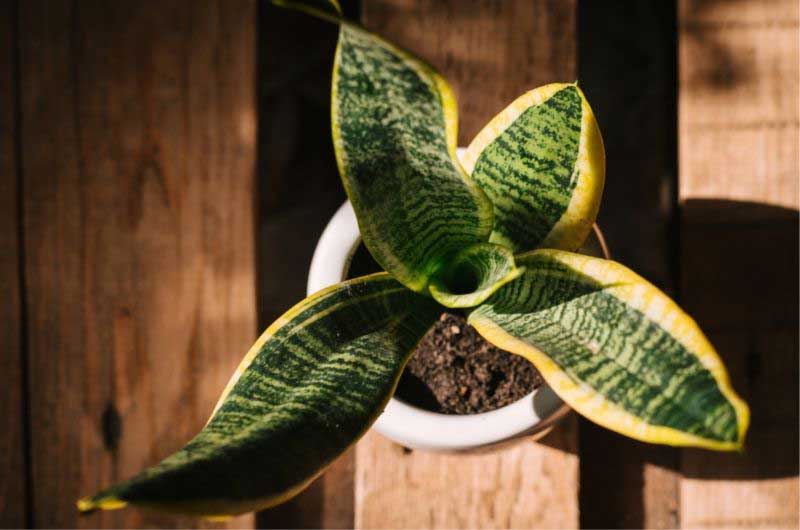How To Make Snake Plants Grow Tall? (Explained)
Snake plants or genus sansevieria are one of the most common plants found in the garden of any plant lover. These succulents grow well as indoor plants and their impressive heights become their main source of attraction.
Owners often find it difficult to make their plants grow tall. This is a problem almost all Snake plants owners face, wondering how to make their Snake plants grow taller. In this article, we will be discussing the reasons why your Snake plant is not growing tall, how to make it grow tall, and of course, a general comprehensive care guide to make your plant thrive to its fullest.
To make your Snake plant grow tall, you can keep your plant in a warm and humid environment that is getting a good amount of bright indirect light. Apart from this, providing a good quality fertilizer, selection of a correct size pot, and providing an adequate amount of water will certainly going to boost up the growth of your Snake plant.
To help your Snake plant to grow faster, you have to choose a pot of the correct size, making sure it’s not too big or too small. You also must keep your plant slightly loose.
Feeding the plant is important if you are looking for impressive results regarding the height of the plant. Pick out some high-grade fertilizers to boost the growth of your plant and make it taller.
The environment in which you have placed your Snake plant also determines its quality of growth. If your plant is kept in a warm and well-lit area, it will grow taller and healthier.
Lastly, watering the plant thoroughly is absolutely essential if you want your Snake plants to grow. Snake plants have long leaves. Watering properly helps the leaves stay green, healthy, and fleshy.

How To Make Snake Plants Grow Tall?
Here are some pointers that will help your Snake plant to grow tall,
Location
Snake Plants can tolerate full sun, however, it is better to keep them in shade. An ideal location is a place with bright indirect sunlight. Place the plant on the northeast-facing window of your room. If you have the plant near a window where it will receive plenty of direct sunlight, change the place as the plant might get scorched.
Soil
These plants are prone to root rot, so you need well-draining soil. Use mixes for succulents and cactus with 50% perlite. Avoid using Vermiculite as it holds water that succulents like Snake plants do not prefer.
If you have regular potting soil, use it with a coarse mixture of sand and perlite. You can also use equal parts of coco peat, perlite, or coarse sand and regular potting soil or sterilized garden soil and use the mixture as a growing medium.
Water
Do not overwater the Snake plant. in summers, the soil should be moist but not wet. Use the finger dipping method to know if the plant needs to be watered. In winter the plant is dormant, so, water as little as possible. Check if the topsoil is dry and water only then. Excessive water can not only stop the plant from growing but also kill it.
Temperature
The ideal temperature range for the best growth of Snake plants is between 70-90o F (21-32o C). As they thrive in warmth, they are not at all tolerant to colder temperatures.
Winterize the plant by keeping them in a warm room, protected from cold drafts in winter. Maintain the soil on a drier side or the soil might freeze and kill the plant. The lowest temperature these plants can withstand is 41o F (5o C) easily.
Fertilizer
Fertilizers during the growing season will definitely improve the growth of your plant. however, don’t overfeed the plant by adding the fertilizers frequently. Also, remember to use diluted fertilizer. Avoid using fertilizers during the dormant stage. April-September is the best time to add fertilizers.
Humidity
Snake plants require humidity and warmth. You can add a humidifier in the area where you have your Snake plant if the area is too dry. Keeping the plant in or near the bathroom is also a great option to improve the humidity of the air.
Repotting
Snake plants are generally slow-growing plants. They need to be repotted every 2 to 3 years when the plant becomes completely rootbound. Also, these plants produce buds that need to be propagated so that the plant focuses all its energy on growing and not flowering.
Pest and Diseases
Spider mites and mealybugs are the two most dangerous plant pests that can kill your Snake plant. they suck out the sap from the plant making it extremely fragile and vulnerable.
To prevent the insects, use a damp paper towel and gently wipe off the leaves or handpick each mite. To prevent further infestation, decrease the humidity of the air since these pests are attracted to moisture.
How To Care For Snake Plant?
Here are some additional tips and tricks to improve the growth of your Snake plant.
Pruning
Pruning is an essential step in the care guide of your Snake plant. Whether your Snake Plant is overgrown or has damaged leaves, pruning the leaves is essential.
Use a sharp, clean blade, and simply cut off the stalks that are dry, damaged, or broken from the base as close to the soil as possible. If the leaf wilting, dried, or rotting, tug the leaf and pull it right from the root. If the leaf is internally damaged, it will come out easily.
Cleaning
Your plant might stop growing due to dust build-up. Take a clean tissue and gently swipe a leaf in between the two-fold of the tissue to get a clean, flesh, green plant.
How To Repot Your Snake Plant?
Since the Snake plant is a house plant, it will grow a lot slower in the wild than it will in the woods. Depending on the size of your plant and the density of the roots, repotting every 2 to 3 years will encourage the growth of your plants and provide more nourishment. These are the things you need to know when repotting your plant.
When to Repot?
When the strong roots become extremely root bound and come out of the pot, know that it is time to Repot the plant.
Pot sizing
If you want a taller plant, find a nursery pot that’s 2” in diameter larger than the pot you are currently using. If you want a plant of the same size, simply change the soil.
Repotting Method
On a newspaper (to not litter the floor) shake off as much soil as possible from the roots and free them. After you have clean roots, place the plant at the center of the pot and gently add new soil.
Water the soil thoroughly and place the plant in an area of bright indirect light. Your plant might be in shock for 2 to 4 weeks due to the new environment, but it will get back to normal soon.
To know about plant propagation, check out this article.
How To Speed Up The Growth Of Snake Plants?
Give the plant plenty of space to grow
One of the most important factors that can speed up the growth of your Snake plant is repotting. Repotting your Snake plant into a container that’s 2” larger than the current pot will give the plant enough place to grow manageably. Small containers can stunt the growth of your plant.
One of the best Snake plants mixes into growing taller is to divide them and repot in 1-gallon containers using a 50/50 DIY mix with well-draining potting soil and cactus potting soil.
Snake plants are naturally slow growers. They produce pups that must be propagated to make the plant grow even taller. Propagating the plant will help the parent plant focus all its energy on growing rather than flowering.
Temperature and Air
Snake plants also have health benefits, like, they are used as air purifiers. This along with the fact that it is mesmerizingly beautiful is why these plants are such great indoor plants. They are tall, strong, and need good airflow.
Good airflow adds to the improved growth of the plant. To boost the temperature and air of the room use terracotta pots as they are porous and help with improves air circulation in the top and side the roots of the plant.
The temperature and the location of the plant are also something you must consider. Keep the plant near a window or an air vent. This will prevent the soil from getting soggy and damaging the roots as there will be plenty of air.
However, be careful during winter. The plant winterproofs itself by becoming dormant. Strong winds and cold drafts can often freeze the plant. The key to tall Snake plants is consistent temperature and airflow.
Lighting
In the case of some Snake plants, the growth depends completely on the lighting. If you keep your plant in a shaded low-light area of your room, it will be alive but the growth, however, will be stunted. Since Snake plants are already slow growers, low light will make the growth even slower.
If your plant is situated in a low light spot indoors, be quick to move the plant to a warm sunny area where lack of light will not slow the growth of the plant.
The ideal amount of light for your Snake plant to grow tall is plenty of indirect sunlight and the ability to cope with at least 2 to 3 hours of direct sunlight.
Make sure to not burn the leaves of your plant with too much sunlight. Long hours of direct sun will scorch your plant and leave yellowing or browning marks on the leaves.
Watering
The trickiest part of growing a house plant is to get accustomed to its watering needs. What you need to remember is that Snake plants absorb water from the humidity in a room. In order to get the ideal watering recruitment for your Snake plant is to get the humidity of your room correct.
Snake plants need only a little water. The soil of your plant should be moist at all times but never wet.
In the case of Snake plants, much like any other plants, underwatering is better than overwatering. This is because, if you underwater your plant, less trouble and effort are required to get your plant back into its original form, but overwatering can kill the plant.
Fertilizer Requirements and Precaution from bugs
In winter your Snake plant is dormant. Therefore, never apply fertilizer when the plant is in a dormant stage. The right time for that is the growing season, during spring. It boosts the growth of the plant as new growth is just about to begin.
Throughout spring and summer, feed your Snake plant with a diluted mix of cactus fertilizer to a quarter weekly up until September or October, then let the plant go into dormancy.
The growing period of the plant is from April to September.
Exceptional Snake Plants That Do Not Grow Very Tall
- The Twisted Sister looks unique compared to other Snake plants. It looks like a bird’s nest and has a maximum height of 12”
- The Golden Hahnii is a dwarf variety that grows in clusters with a rosette pattern. Its mature height is 12”
- Sansevieria ehrenbergii ‘Banana’ is a true dwarf with a height of 6”
- Cleopatra Snake plants grow 11”
- The Kenya Hyacinth is similar to Golden Hahniji and grows up to a height of 16”
Best Tall Growing Snake Plant Species
- The Laurentii has a mature height between 2 to 4 feet.
- The Black Gold reaches up to the height of 35”
- The Futura Superba has an impressive height of 24”. That might be the highest mature age, but this species can also max out at 12”. It is sort of like the Black Gold Variety with a lighter shade of leaves and shorted and wider leaves.
How Much Time Does A Snake Plant Need To Grow?
Snake plants grow slow by nature. If you give your plant the right care and nourishment, you can expect your Snake plant to grow at least by 2-inches per year. Hence, your plant will keep growing until it reaches its maximum mature height. For instance, a Black gold will grow up to a height of 35” but a Golden Hahnji will not exceed 12”.
Last Words
So, these were the steps by which you can make your Snake plants grow fast and stop them from dwarfing. We have discussed all major points regarding why your Snake plant is not growing tall, how to make it grow tall and a general comprehensive care guide to make your plant thrive to its fullest.







